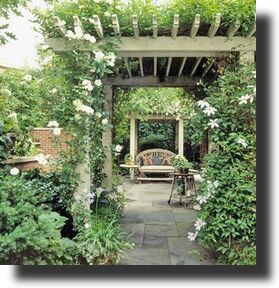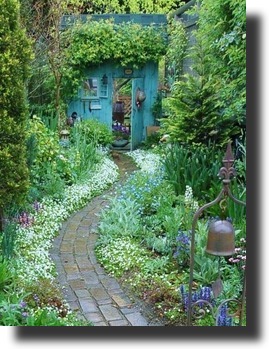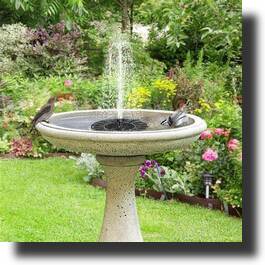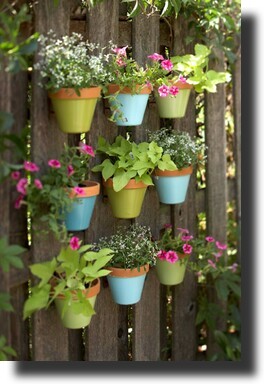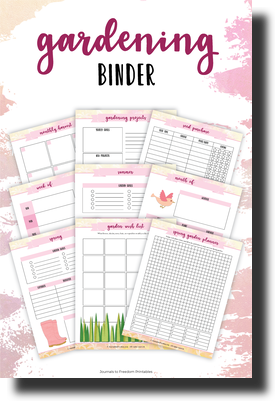I first heard about English Zen Gardens on a Facebook social media page and was instantly captivated by the concept. Zen, to be clear, is neither a faith nor a philosophy. It refers to the intangible interconnected nature of all life. It’s the peaceful meditative mindset and practice of returning to the naturalness and ease of our authentic selves.
English gardens, however, are tangible. They are the visible architecture of romantic gardens filled with color and life, neatly trimmed boxwoods and overflowing flower beds. Complete with weaving pathways, a water element, and seating areas, English gardens combine formality with whimsy.
Isn’t that delicious? If the thought speaks to you, but you’re not sure how to get started transforming your yard into your ideal outdoor space, this guide is just for you.
In it, we’ll look at the elements of an English Zen Garden. We’ll go over three cost-cutting dos and don’ts to keep in mind as you plan your transformation, as well as a simple four-step approach for turning your vision into a garden that gives you bursts of color, points of interest, and respite all year round. Let’s dig in.
The essential elements
Themed rooms, groupings and defined spaces
Design your garden as a series of themed rooms, themed beds, or themed seating areas, depending on its size. By designing it as separate themed spaces, you can experiment with different style ideas and color schemes, eventually creating a map of what your garden will be.
At this point in the planning process, you should go online and do some research to understand climate suitability, eventual plant height and width, and blooming times for the plants you want to put in each themed space. Consider the intended purpose of each themed space as well.
∘ is one of the rooms designated as a playroom?
∘ is another for doing morning stretches outside or sipping coffee while scanning emails before heading out to work?
∘ perhaps you’d like a quiet place for daily meditation or a place for entertaining friends and family?
Unlike gardens in North America, which are open concept, gardens in the English tradition can have a garden within a garden and secret hidden nooks (size permitting).
Rooms and nooks can be divided by physical walls, such as living walls, latticework, bamboo, climbing roses, weathered barn wood, evergreens, bricks, and picket fences. Or they can be defined by what is in each space (as example, color groupings) and not by an actual physical structure. You have complete control and the choice is entirely yours.
Now that we’ve gone over themed rooms and defined spaces, we’ll look at another aspect of your soon-to-be English Zen Garden. This is a layering element.
Layering
A key element of an English Zen Garden is layering with plants and shrubs of varying heights and colors, and different bloom times. This will give you endless color and points of interest, including vertical points of interest, from spring on through fall.
Are you wondering about winter? For winter you’ll want to include evergreen trees and shrubs. Focal points such as a bird feeder, sculptures and garden structures can also give you pops of color and points of interest during winter months.
Pathways
Privet lined pathways are the hallmark of English gardens. With or without privets, pathways are an essential and powerful design element. They will provide a logical flow to your English Zen Garden and connect you to your points of interest, making them more than just eye candy. Pathways can also be used to frame themed rooms and spaces.
Pathways don’t need to be expensive to be stunning. Home Stratosphere offers 75 Garden Path Ideas and Designs, with pictures.
When it comes to deciding what is best for your garden, you have a lot to think about and a lot of decisions to make. So, check them out and begin mulling over the pathway elements you want to include in your design.
Your water element
You’ve probably seen Zen gardens with only a sand bed and no water feature. In areas where there is no water, sand is used as a symbolic substitute for water. Those who look after these gardens rake the sand to make symbolic waves.
Other than because of being in a desert area, a Zen garden includes at least one water element. You can quickly and cheaply install a water feature in your garden, such as a cascading waterfall, a reflection pool, or a fountain using a solar-powered water pump.
He-sheds, she-sheds, pergolas, and trellises
She-sheds are awesome. Too awesome for women to have had a monopoly on them for very long. These days there are he-sheds and she-sheds, both of which offer personalized me space and destinations, as well as points of interest in your garden.
If you have enough room, you can include multiple focal points in your design. A trellis. A pergola. An arbor. A sundial. A bench. Or perhaps a swing. Having said that, the goal is not to create a cluttered garden, but rather one that is as interesting as it is beautiful, with places to play as well as quiet places for reflection and meditation.
Vertical focal points
A vertical point of interest can be something as simple as a pine tree that stays green all winter, or a painted bird feeder dangling from the branch of a snow laden hawthorn tree that you glance up and notice on a cold winter’s day.
Vertical points of interest are especially useful for small gardens, or even balconies. They add height and depth to an otherwise small space.
Whether you have a large space or a small space, your focal points will draw your eyes to them and make the space more appealing.
Important Dos & Don’ts for your garden transformation
☑ Do take stock
Creating an English Zen Garden doesn’t have to cost a bundle, and it doesn’t mean everything in your yard needs to go. Let’s take stock.
∘ are there old patio stones that can be moved and repurposed as a pathway?
∘ can some plants be relocated?
∘ is there a pergola that can be refreshed with a coat of paint?
Make a list of what has to go and what can stay and be incorporated into the new footprint. An old metal pergola can be painted. A dirty patio can be cleaned. If cleaning isn’t enough, it can be framed, covered in landscape fabric, and topped with layer of pea gravel. Or it can be disassembled and the patio stones repurposed to create pathways in other areas of your garden.
☑ Do learn how to propagate plants
While some people consider Zen as a minimalist concept, it can also be very colorful and abundant, just as nature is.
In contrast to the North American tradition of summer annuals like impatiens, geraniums, and petunias, English gardens rely heavily on early to late-blooming perennials like roses, daisies, clematis and peonies.
Plants can be expensive, so learning how to make plants for free will come in handy. This is done by starting from seeds, propagating, and dividing. When you know how the process works, you can ask friends for cuttings from their gardens, or you can take a single plant and grow many more plants from it.
For beginner gardeners, a link at the bottom of this guide will take you to a website where you can start learning how to propagate plants.
☑ Don’t wrestle with topography
We must work cooperatively with the terrain when designing a new garden footprint. Be flexible and accommodating, and look for simple solutions to potential issues caused by slopes, soil types, and weather. Here are a few ideas for achieving harmony with common landscape issues:
∘ creating several tiers on a sloped property, or sloped area of your property, actually helps prevent erosion. It gives you the platform to layer different plants and shrubs, as well as add landscaping elements for a sturdy design
∘ soil issues can usually be resolved quickly and easily by mixing new garden soil into the existing soil
∘ in terms of weather, it’s essential for you to understand which plants and shrubs thrive in your area. Simply put, palm trees don’t grow in the Artic
Refurbishing and repurposing items that are already in your garden or picking them up for a low-cost at garage sales, propagating plants, and working with the natural terrain all fit into a Zen framework. Zen isn’t about frivolous or unnecessary spending, or even about spending at all. It is about peace, flow, and calm, as well as feeling connected to everything around you.
How easy was that? Building an English Zen Garden will be a breeze if you cultivate the Zen mindset and go with the flow instead of struggling with the tasks at hand.
We’re close to completing our journey, just an easy four-step plan to go over and then you’ll be ready.
Four-step plan
① Design
You can grab a pencil and paper now and begin sketching your design, or make use of free online garden design apps, such as SmartDraw.
② Timetable / Calendar
There are several websites that offer free printable garden planners. Depending on the size of your yard, the transformation could take weeks, months, or even years. Printable garden planners can help you stay organized by creating a timetable for the tasks at hand. They can also be used for keeping track of the best planting times for your new garden.
③ Budget
Estimate your costs, including any professional services you may need. You don’t have to spend a lot of money to grow your English Zen Garden. When money is tight, get creative and look for ways to cut costs.
④ Execution
Are you ready to get to started? Is this a project you’ll tackle on your own, or do you need to enlist help? Now that you have a plan, it’s time to decide how you’re going to carry it out.
Incredible health benefits of gardening
While your English Zen Garden will add new character, beauty and boundless utility to your outdoor space, gardening gives you a sense of purpose. Before we go, let’s take a quick peek at the health benefits this project will bring to you.
∘ a sense of accomplishment
∘ can increase family time
∘ improved appetite
∘ improved mood
∘ improved immune system
∘ improved mental clarity
∘ improved quality of sleep
∘ improved self esteem
∘ reduced risk of heart attack
∘ reduced stress levels
∘ you’ll feel stronger
Did this articles motivate you to get started on your own English Zen Garden? Send me an email and let me know. I welcome your feedback - contact@insidemyoffice.ca.
Do you need content? I can help.
Email me today – contact@insidemyoffice.ca.
UNLESS STATED OTHERWISE All content on this site is written & edited by: J. Emily Somma, BA Copywriter & Editor Inside my Office © 2021
USEFUL LINKS:
Eight plants that bloom continuously through three seasons
Eighteen great DIY garden points ideas
FREE Garden Design & Layout Software
Garden wall ideas – create a boundary or define a space with a vertical structure
Propagating plants for beginners

